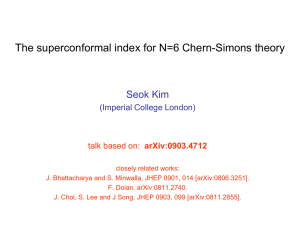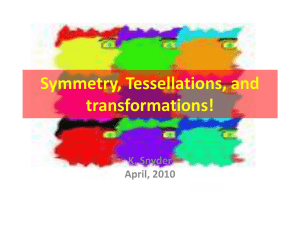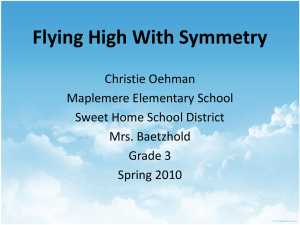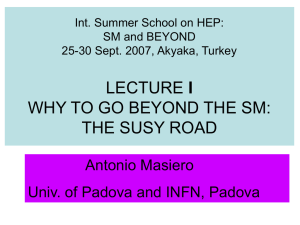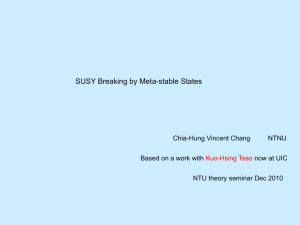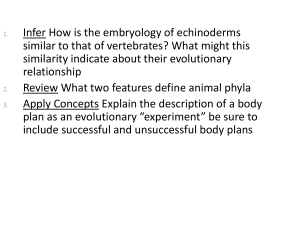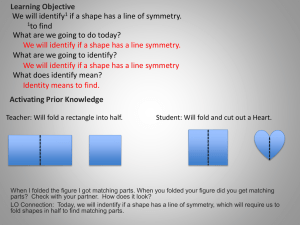Antoine van Proeyen
advertisement
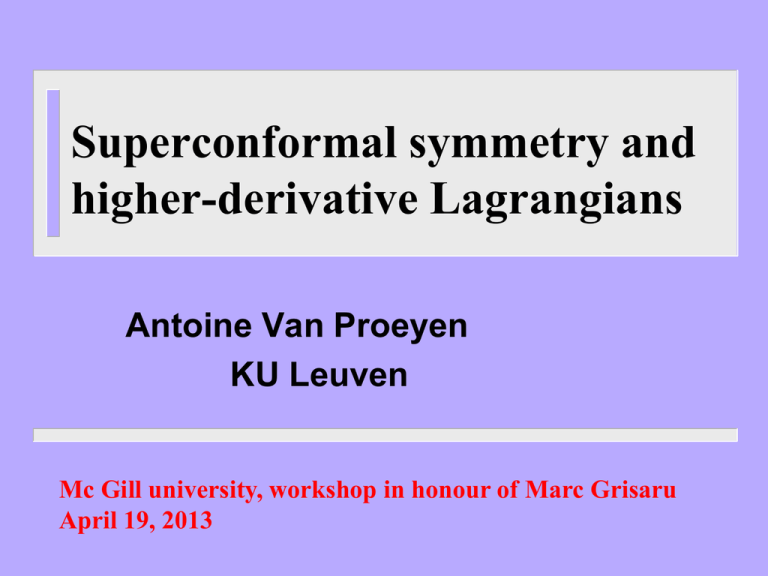
Superconformal symmetry and higher-derivative Lagrangians Antoine Van Proeyen KU Leuven Mc Gill university, workshop in honour of Marc Grisaru April 19, 2013 My experience with Marc First encounter: on boat to Cargèse 1979 Only one paper together but many long discussions, e.g. while walking along the sea in Trieste on massive gravitino superfield and very nice moments together Interest in higher-derivative terms appear as ®0 terms in effective action of string theory corrections to black hole entropy higher order to AdS/CFT correspondence counterterms for UV divergences of quantum loops Plan 1. 2. 3. 4. What we know about general sugra/susy theories The superconformal method Higher derivative sugra actions and sugra loop results Dirac-Born-Infeld− Volkov-Akulov and deformation of supersymmetry (example of an all order higher-derivative susy action) 5. Conclusions 1. What we know about general sugra/susy theories Strathdee,1987 The map: dimensions and # of supersymmetries D susy 11 M 32 24 20 16 12 8 4 M 10 MW IIA IIB 9 M N=2 I N=1 8 M N=2 N=1 7 S N=4 N=2 6 SW (2,2) (2,1) 5 S N=8 N=6 4 M N=8 (1,1) (2,0) N=4 N=2 N=6 N=5 N=4 SUGRA/SUSY SUGRA vector multiplets (1,0) tensor multiplet N=3 SUGRA N=2 N=1 SUGRA/SUSY vector multiplets + multiplets up to spin 1/2 Higher-derivative actions: no systematic knowledge without higher derivatives: ungauged and gauged supergravities. Insight thanks to embedding tensor formalism Various constructions of higher derivative terms - e.g. susy Dirac-Born-Infeld: Deser, Puzalowski, 1980; Cecotti, Ferrara; Tseytlin; Bagger, Galperin; Roček; Kuzenko, Theisen; Ivanov, Krivonos, Ketov; Bellucci, but no systematic construction, or classification of what are the possibilities; (certainly not in supergravity) 2. The superconformal method from one thousand and one lectures conformal scalar action (contains Weyl fields) local conformal symmetry Gauge fix dilatations and special conformal transformations Poincaré gravity action local ¡ symmetry Superconformal construction The idea of superconformal methods Difference susy- sugra: the concept of multiplets is clear in susy, they are mixed in supergravity Superfields are an easy conceptual tool for rigid susy (Super)gravity can be obtained by starting with (super)conformal symmetry and gauge fixing. With matter: Before gauge fixing: everything looks like in rigid supersymmetry + covariantizations The strategy : superconformal construction of N=1 supergravity chiral multiplet + Weyl multiplet superconformal action Gauge fix dilatations, special conformal transformations, local R-symmetry and special supersymmetry Poincaré supergravity action S. Ferrara, M. Kaku, P.K. Townsend. P. van Nieuwenhuizen, 1977-78 More explanations Superconformal construction of N=4 supergravity De Roo, 1985 Weyl multiplet + 6 gauge compensating multiplets (on-shell) superconformal action no flexibility in field equations !! gauge-fixing Weyl symmetry, local SU(4), local U(1) , S-supersymmetry and K-conformal boosts pure N=4 Cremmer-Scherk-Ferrara supergravity 3. Higher derivative supergravity actions and supergravity loop results many miraculous cancellations have been found is there an underlying hidden symmetry ? If there are divergences: supersymmetric counterterms should exist (or supersymmetry anomalies) We do not know enough to be sure whether (or which type of) invariants do exist. Higher derivative sugra actions for low N there is a superconformal tensor calculus: allows to construct counterterms and even anomalies → superconformal symmetry allows divergences. for N=4: superconformal symmetry can be defined, but no construction of counterterms (or anomalies) - difficulty: on-shell susy algebra: to change action (add counterterms), one has to change simultaneously the transformations. How do we get anomalies for low N from tensor calculus ? de Wit, Grisaru 1985 Anomalies from tensor calculus for low N ? (here N=1) de Wit, Grisaru 1985 N=1: local superconformal anomalies satisfying Wess-Zumino consistency condition can be constructed using superconformal tensor calculus Compensator superfield transforms as for How for N=4 ? No tensor calculus; no auxiliary fields; only on-shell construction: no flexibility in field equations How to establish the existence/non-existence of the consistent order by order deformation of N=4 on shell superspace ? Conjecture: if it does not exist: explanation of finiteness (if Bern et al do not find N=4, D=4 is divergent at higher loops) Until invariant counterterms are constructed (conformal?) we have no reason to expect UV divergences Two points of view 1. Legitimate counterterms are not available yet 2. Legitimate counterterms are not available, period ??? S. Ferrara, R. Kallosh, AVP, 1209.0418 “We are trying to prove ourselves wrong as quickly as possible, because only in that way If the UV finiteness will persistcan in higher one would like to we findloops, progress.” (Feynman) view this as an opportunity to test some new ideas about gravity. E.g. : is superconformal symmetry more fundamental ? N=4 conjecture Repeat: Classical N=4 is obtained from gauge fixing a superconformal invariant action: The mass MPl appears in the gauge-fixing procedure Bergshoeff, de Roo, de Wit, van Holten and AVP, 1981; de Roo, 1984 Analogy: • Mass parameters MW and MZ of the massive vector mesons are not present in the gauge invariant action of the standard model. • Show up when the gauge symmetry is spontaneously broken. • In unitary gauge they give an impression of being fundamental. • In renormalizable gauge (where UV properties analyzed) : absent S. Ferrara, R. Kallosh, AVP, 1209.0418 4. Dirac-Born-Infeld− Volkov-Akulov and deformation of supersymmetry on the search of deformations of N=4 theories, we find all-order invariant actions in rigid susy with extra supersymmetries (Volkov-Akulov (VA) – type) E. Bergshoeff, F. Coomans, C. Shahbazi, R. Kallosh, AVP, arXiv:1303.5662 Dim Bottom-up approach: start deformations gauge field (D-2) on-shell dof; fermion = #spinor comp / 2 Spinor min.# comp 2 MW 1 3 M 2 4 M 4 5 S 8 6 SW 8 7 S 16 8 M 16 9 M 16 10 MW 16 11 M 32 The map: dimensions and # of supersymmetries D susy 11 M 32 24 20 16 12 8 4 M 10 MW IIA IIB 9 M N=2 I N=1 8 M N=2 N=1 7 S N=4 N=2 6 SW (2,2) (2,1) 5 S N=8 N=6 4 M N=8 (1,1) (2,0) N=4 N=2 N=6 N=5 N=4 SUGRA/SUSY SUGRA vector multiplets (1,0) tensor multiplet N=3 SUGRA N=2 N=1 SUGRA/SUSY vector multiplets + multiplets up to spin 1/2 Dim Bottom-up approach: start deformations 2 3 4 5 6 7 gauge field (D-2) on-shell dof; fermion = #spinor comp / 2 Spinor min.# comp MW 1 D=10: MW; M 2 D=6 SW; M 4 D=4 M; S 8 SW 8 D=3 M; S 16 D=2 MW 8 M 16 9 M 16 10 MW 16 11 M 32 extra (trivial) fermionic shift symmetry normalization for later use Bottom-up deformation answer unique up to field redefinitions also transformation rules deformed. As well ² as ´ parameter transformations can be defined e.g. Only identities used that are valid in D=10,6,4,3, e.g. cyclic (Fierz) identity looks hopeless to continue to all orders continues from work in D=6 : E. Bergshoeff, M. Rakowski and E. Sezgin, 1987 Dp-brane action Start with –symmetric Dp brane action Dp brane: IIB theory m=0,..., 9 and ¹=0,..., p=2n+1 space-time coördinates Xm; µ is doublet of MW spinors; F¹º AbelianSame fieldapplies strengthfor D=6 (2,0) (also called iib): Symmetries: m=0,...,5 rigid susy doublet ²1; ²2 local symmetry doublet (effectively only half (reducible) symmetry) Also D=4 N=2, m=0,...,3 (BH solutions) world volume gct After gauge fixing worldvolume gct »m’ and symmetry gauge-fixed: only one fermion, ¸, remains ²1 and ²2 supersymmetries preserved suitable combinations are called ² and ³ : act as -ordinary susy: deformed at order ® -VA susy Complete DBI-VA model for the p=9 case Expanding the all-order result, one re-obtains indeed the result that was obtained in the bottom-up calculation to order ®2 This proves that our all-order result is indeed the full deformation that we were looking for ! The map: dimensions and # of supersymmetries D susy 11 M 32 24 20 16 12 8 4 M 10 MW IIA IIB 9 M N=2 I N=1 D9 8 M N=2 D7N=1 7 S N=4 N=2 6 SW (2,2) (2,1) 5 S N=8 N=6 4 M N=8 D5(1,1) (2,0) N=4 N=2 N=6 N=5 D3 N=4 SUGRA SUGRA/SUSY vector multiplets (1,0) tensor multiplet N=3 SUGRA N=2 N=1 SUGRA/SUSY vector multiplets + multiplets up to spin 1/2 The map: dimensions and # of supersymmetries D susy 11 M 32 24 20 16 12 8 4 M 10 MW IIA IIB 9 M N=2 I N=1 D9 8 M N=2 D7N=1 7 S N=4 N=2 6 SW (2,2) (2,1) D5(1,1) (2,0) 5 S N=8 N=6 N=4 N=2 4 M N=8 N=6 N=5 D3 N=4 N=3 V3 N=2 SUGRA vector multiplets SUGRA/SUSY tensor multiplet V5(1,0) SUGRA N=1 SUGRA/SUSY vector multiplets + multiplets up to spin 1/2 5. Conclusions Superconformal symmetry has been used as a tool for constructing classical actions of supergravity. Uses many concepts of superspace, reformulated as multiplets transforming under superconformal group. We do not have a systematic knowledge of higher-derivative supergravity actions. Can (broken) superconformal symmetry be an extra quantum symmetry? The non-existence of (broken) superconformal-invariant counterterms and anomalies in N=4, D=4 could in that case explain ‘miraculous’ vanishing results. We are studying new constructions of higher-derivative actions using gauge-fixed brane actions. For now: rigid supersymmetry. More work to do ... Import in superconformal or there is still always many happy returns !
